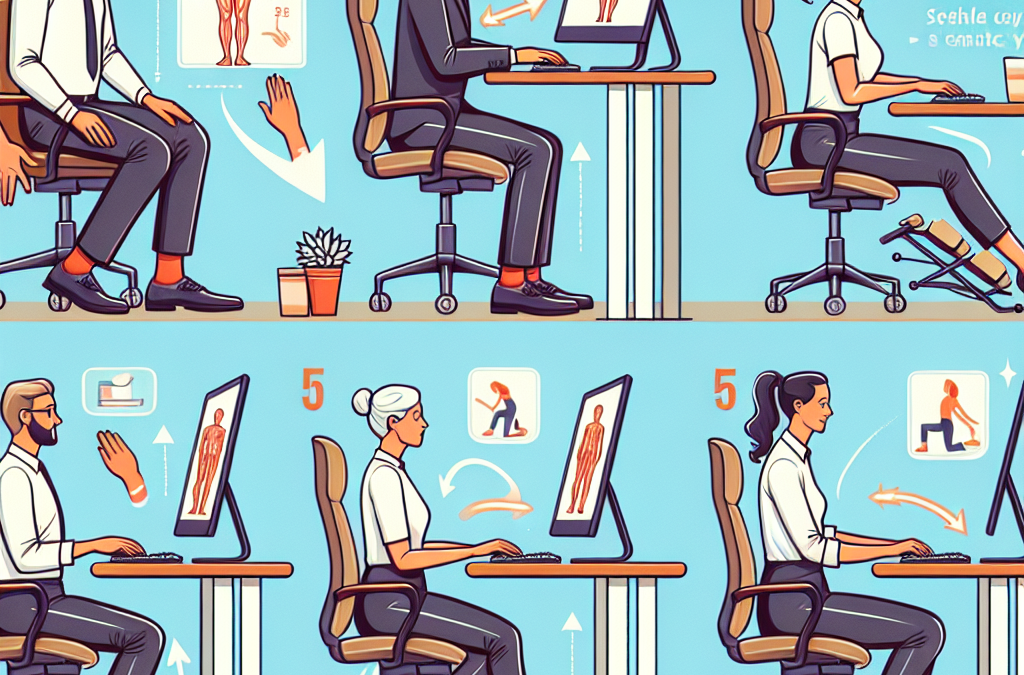[ad_1]
Many of us spend hours sitting at a desk for work or school, which can drastically affect our posture over time. Poor posture can lead to many health issues, including back and neck pain, headaches, and reduced mobility. Fortunately, there are simple steps you can take to improve your posture while sitting at your desk. Here are five ways to help you sit up straight and feel better:
1. Maintain Good Posture
Maintaining good posture is one of the most important ways to improve your posture while sitting at your desk. Keep your back straight, shoulders back, and feet flat on the floor. Avoid slouching or leaning to one side. If you catch yourself slouching, gently remind yourself to sit up straight. Over time, practicing good posture will become a habit, and you will feel the benefits of proper alignment. Remember to take breaks and stretch regularly to prevent stiffness.
2. Adjust Your Chair
It is essential to have an ergonomic workspace to support good posture. Adjust your chair so your feet are flat on the floor, and your thighs are parallel to the ground. Your knees should be at a 90-degree angle. Ensure your chair provides lumbar support to help maintain the natural curve of your lower back. Consider using a cushion or rolled-up towel for extra support if your chair is not adjustable. A comfortable chair will help you sit properly and reduce strain on your back and neck.
3. Position Your Computer Screen at Eye Level
Another important factor in maintaining good posture while sitting at your desk is the position of your computer screen. Place your screen at eye level to prevent straining your neck. You should be able to look straight ahead without tilting your head up or down. Adjust the height of your monitor or use a monitor stand to achieve the proper eye level. Additionally, position your keyboard and mouse close to your body to avoid reaching forward, which can strain your shoulders and upper back.
4. Take Frequent Breaks
Sitting for long periods can strain your body and lead to poor posture. To prevent this, take frequent breaks throughout the day. Stand up, stretch, and walk for a few minutes every hour. Set a timer or use a reminder app to prompt you to take breaks regularly. Moving your body will help alleviate stiffness, improve circulation, and reduce the risk of developing musculoskeletal issues. Incorporate simple stretches and exercises into your break routine to keep your body limber and strong.
5. Use a Posture Corrector
If you find maintaining good posture on your own challenging, consider using a posture corrector. A posture corrector is a device that helps align your spine and shoulders properly. It provides gentle support to remind you to sit up straight and prevent slouching. Various types of posture correctors are available, including braces, straps, and cushions. Choose one that is comfortable and adjustable to fit your body shape. Regular use of a posture corrector can help retrain your muscles and improve your posture over time.
Improving your posture while sitting at your desk is essential for overall health and well-being. By practicing good posture, adjusting your workspace, taking breaks, and using a posture corrector, you can reduce the risk of developing posture-related issues and feel more comfortable throughout the day. Remember to listen to your body and adjust as needed to ensure you sit in a way that supports your spine and muscles. With consistency and mindfulness, you can positively impact your posture and enjoy the benefits of a strong and aligned body.
Q: How long do I need to sit upright at my desk correctly?
A: Sitting upright at your desk for no more than 30 minutes at a time is recommended. Take short breaks to stand up, stretch, and walk around to avoid stiffness and strain on your body.
Q: Will using a posture corrector help improve my posture permanently?
A: A posture corrector can help retrain your muscles and develop better posture over time. However, practicing good posture habits on your own is essential to maintain long-term improvements.
Q: How can I adjust my workspace ergonomically for better posture?
A: To improve your workspace ergonomics, ensure your chair, desk, and computer are set up in a way that supports proper alignment. Adjust your chair height, screen position, and keyboard placement to reduce strain on your body while sitting.
[ad_2]






